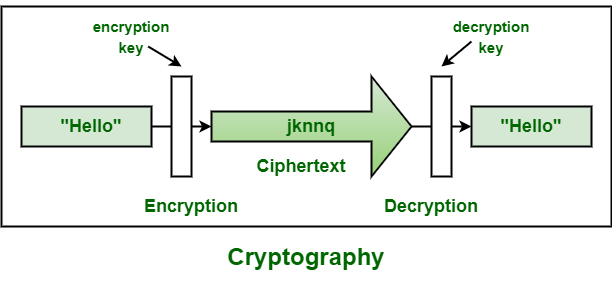【数据加密】密码学教程
视频号
微信公众号
知识星球
密码学是一种通过将明文转换为难以理解的密文来确保通信安全的技术。它涉及各种算法和协议,以确保数据的机密性、完整性、身份验证和不可否认性。密码学的两种主要类型是对称密钥密码学和非对称密钥密码学。它在确保当今数字世界中信息的安全和隐私方面发挥着至关重要的作用,能够实现安全的在线交易,保护存储在数据库中的敏感数据,并确保通信的机密性。随着技术的不断进步,密码学仍然是保护我们的信息免受黑客攻击的关键工具。

在本密码学教程中,我们介绍了密码学的基础和高级概念,包括对称密钥密码学、非对称密钥密码学以及密码分析、公钥密码学等。它为密码学的核心概念提供了坚实的基础,并深入了解了其实际应用。
在本教程结束时,您将基本了解密码学是如何工作的,以及如何使用它来保护您的信息。
What is Cryptography?
Cryptography is a technique of securing information and communications through the use of some algorithms so that only those persons for whom the information is intended can understand it and process it.
Cryptography Tutorial Index
Here are the latest topics of cryptography(basics to advanced):
Cryptography – Table of Content
- Introduction
- Types of Cryptography
- Data Encryption Standard (DES)
- Advanced Encryption Standard (AES)
- Public Key Cryptography Algorithms and RSA
- Cryptology, Cryptography and Cryptanalysis
- Common Used Cryptography Techniques
- Data Integrity in Cryptography
- Important Difference b/w topics of Cryptography
Introduction
- Introduction to Cryptography
- History of Cryptography
- Cryptography Principles
- Cryptography and its types
- Advantages and Disadvantages of Cryptography
- Applications of Cryptography
- What is Cryptosystem?
- Components of Cryptosystem
- Attacks on CryptoSystem
Types of Cryptography
- Symmetric Key Cryptography
- Stream Cipher
- Block Cipher
- Substitution techniques
- Ceaser Cipher
- MonoAlphabetic Cipher
- Playfair Cipher
- Hill Cipher
- Polyalphabetic Cipher
- One-Time Pad
- Transposition Techniques
- Steganography
- Asymmetric Key Cryptography
- Hash Functions
Data Encryption Standard (DES)
- What is data encryption?
- Encryption Algorithms
- Strength of Data encryption standard (DES)
- Double DES and Triple DES
- Difference between MD5 and SHA1
- Difference between RSA algorithm and DSA
- Difference between RSA and Diffie-Hellman
Advanced Encryption Standard (AES)
- Introduction to AES
- AES Structure
- AES Transformation Function
- Substitute Bytes Transformation
- ShiftRows Transformation
- MixColumns Transformation
- AddRoundKey Transformation
- AES Key Expansion Algorithm
- AES Examples
- Implementation of AES
- Difference between AES and DES ciphers
Public Key Cryptography Algorithms and RSA
- What is Public Key Cryptography?
- Four asymmetric public-key algorithms
- Rivest-Shamir-Adleman (RSA)
- Elliptic Curve Digital Signature Algorithm (ECDSA)
- Digital Signature Algorithm (DSA)
- Diffie-Hellman key agreement protocol
Cryptology, Cryptography and Cryptanalysis(密码学、密码学和密码分析)
- Introduction to Cryptology
- Types of Cryptology
- Cryptography
- Cryptanalysis
- Introduction to Cryptanalysis
- Types of Cryptanalytic Attacks
- Cryptology v/s Cryptography
- Cryptography v/s Cryptanalysis
- Cryptology v/s Cryptanalysis
Common Used Cryptography Techniques
- Custom Building Cryptography Algorithms (Hybrid Cryptography)
- An Overview of Cloud Cryptography
- Quantum Cryptography
- Image Steganography in Cryptography
- DNA Cryptography
- One Time Password (OTP) algorithm in Cryptography
- Modern Cryptography
Data Integrity in Cryptography
- Cryptography Hash functions
- Message Authentication
- Cryptography Digital signatures
- Public Key Infrastructure
Important Difference b/w topics of Cryptography
- Classical Cryptography and Quantum Cryptography
- Difference between Steganography and Cryptography
- Difference between Encryption and Cryptography
- Difference between Cryptography and Cyber Security
- Difference between Hash functions, Symmetric, and Asymmetric algorithms
- Difference between Stream Cipher and Block Cipher
密码学的特点
以下是密码学的一些功能:-
- 保密性:加密技术通过将敏感信息转换为不可读的形式,使其对黑客隐藏。
- 完整性:加密技术确保您的数据在传输或存储过程中保持完整和不变。
- 身份验证:密码学有助于验证发送者的身份并确认消息的来源。
- 不可否认性:密码学防止发送者拒绝参与消息或事务。
- 密钥管理:加密技术安全地管理用于加密和解密的密钥。
- 可伸缩性:密码学可以处理不同级别的数据量和复杂性,从单个消息到大型数据库。
- 互操作性:密码学允许不同系统和平台之间的安全通信。
- 适应性:密码学不断发展,以领先于安全威胁和技术进步。
密码学是如何工作的?
- ■明文:这是作为输入输入到算法中的原始可理解消息或数据。
- ■加密算法:加密算法对明文进行各种替换和转换。

密码学是如何工作的?
- ■密钥:密钥也被输入到加密算法中。密钥是一个独立于明文和算法的值。该算法将根据当时使用的特定密钥产生不同的输出。算法执行的精确替换和转换取决于密钥。
- ■密文:密文是作为输出产生的加扰消息。这取决于明文和密钥。对于一个给定的消息,两个不同的密钥将产生两种不同的密文。密文显然是一个随机的数据流,就目前情况来看,它是难以理解的。
- ■解密算法:这本质上是反向运行的加密算法。它获取密文和密钥并生成原始明文。
例如:-假设你想给你的朋友发一条秘密信息。你可以把信息写在一张纸上,然后封在信封里。然而,如果有人截获了信封,他们可以打开信封阅读信息。相反,您可以使用加密算法对消息进行加密。这将把信息转换成未经授权的个人无法读取的密文。
然后,你可以将密文发送给你的朋友,他可以使用相同的加密算法和密钥对其进行解密。密码系统的安全性取决于密码算法的强度和密钥的保密性。如果加密算法较弱,那么可能会破坏加密并读取明文。如果密钥不保密,那么它们可能会被泄露,这将允许未经授权的个人解密密文。
密码学的应用
- 用途:密码学广泛应用于各个领域,以确保数据安全和保护敏感信息。
- 安全通信:加密技术使加密消息应用程序和虚拟专用网络(VPN)等安全通信渠道能够保护通过互联网传输的对话和数据。
- 电子商务和在线交易:密码学在确保电子商务交易、在线银行和数字支付系统的安全方面至关重要。它保护敏感的金融信息,如信用卡详细信息和个人身份号码(PIN)。
- 密码存储:安全地存储密码对于防止未经授权访问用户帐户至关重要。哈希和盐析等加密技术有助于在数据泄露的情况下保护密码不易被泄露。
- 数字版权管理(DRM):数字版权管理系统使用密码学来加强版权保护,并防止未经授权复制或分发数字内容,如电子书、音乐和电影。
密码学常见问题解答
1.密码学的目的是什么?
密码学的目的是通过以只有授权方才能理解的方式对敏感信息进行编码来保护敏感信息。
2.非对称密钥密码学是如何工作的?
非对称密钥密码学通过使用一对数学上相关的密钥来工作:一个用于加密的公钥和一个用于解密的私钥。
3.哪些是常用的对称密钥算法?
常用的对称密钥算法包括AES(高级加密标准)、DES(数据加密标准)和3DES(三重数据加密标准(Triple Data Encryption Standard))。
4.量子计算机能破坏现有的密码系统吗?
量子计算机有可能打破现有的密码系统,因为它们能够比传统计算机更快地解决某些数学问题。
5.密码学是如何在电子商务交易中使用的?用一行字回答这些问题
加密技术用于电子商务交易,在传输过程中对信用卡信息等敏感数据进行加密,以确保其机密性和完整性。
- 44 次浏览


